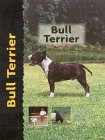
Bull Terrier
Bull Terriers, also sometimes called English Bull Terriers, were bred for dog fighting, and were created from breeding terriers with ancestors of bulldogs. Bull Terriers are striking looking dogs. They are bigger than Staffordshire Bull Terriers, and have longer muzzles and no stop, rather the top of their heads slopes gently. This gives them a generally more dignified air than Staffies, though they also have a distinctly quirky appearance, and love to clown.
Bull Terriers have some similarities to Staffies in character, being courageous, active and playful, though they tend to be calmer. Like Staffies, they are active dogs, which need attention and something to do, or they tend to do things you would rather they didn't, like chewing the furniture, if they are left alone all day. Like Staffies, Bull Terriers also need to be socialized carefully, both with people and other dogs, and have house rules laid down from when they are pups.
Bull Terriers can be very headstrong, hence the need to be consistent about house rules. They should be trained to be calm around children with bicycles, since otherwise they can get over-excited, as a high-profile UK court case has shown! This takes time, since the breed has a tendency to want to join in any exciting activity which is happening, so it's safer to keep them on the lead when walking them anywhere near playing children. They are very fast movers, and it is difficult to stop them once they are in full flight, though a well-trained Bull Terrier should obey a recall command if given before they start a charge! Bull Terriers also need to learn the command 'leave' from when they are pups, and to be taught to drop objects on command when they are little. The drop command can be reinforced through tug games which incorporate a 'drop', a 'sit' and a throw.
Bull Terriers are affectionate and like attention, which helps in training them. Well-bred, well-trained and well-socialized Bull Terriers that have enough exercise are usually very good with children, both tolerant and gentle, but individuals that don't get enough exercise are likely to be very bouncy, and can easily knock small children over. Visiting children who are sensible generally get on well with Bull Terriers, though adult supervision is needed in case the dog gets overexcited with children screaming and running, or children unwisely decide to tease the dog. Bull Terriers have strong jaws which can do a lot of damage.
Any breed created for dog fighting has more potential to become dog-aggressive. Well-socialized bull terriers can get on very well with some other dogs. They can enjoy playing games with other dogs of more robust breeds, and can be very calm when being yapped at by other dogs. It's not that Bull Terriers are quick to fight, on the contrary, they tend to be relatively calm. The problem is more that if Bull Terriers do fight seriously, they can do more damage than most dogs, and because other dogs sometimes have trouble 'reading' their body language, dogs they meet don't always know when to back off and stop harassing a Bull Terrier.
Dog walkers you meet may also blithely tell you their pushy dog is friendly, and not see stiffening and other indicators that your Bull Terrier does not appreciate a pushy dog in his face, so you may need to practise ways of discouraging imprudent walkers from doing this. It is safer to keep Bull Terriers on the lead if they are walked where they are likely to meet strange dogs, because of their potential for aggression against other dogs, even if they appear friendly as youngsters, since aggression against other dogs does not always appear until Bull Terriers are adults. They can be left off the lead for supervised play with dogs they have always got on with. It's safer to get a dog and a bitch if you get more than one Bull Terrier.
They don't need a lot of grooming, as a short-haired breed, but can be barky. This is a good thing if you want a watchdog, but can create problems with neighbours if uncontrolled. Dogs that have enough exercise generally bark less.
There is a miniature version of the Bull Terrier which can be somewhat less reliable in terms of temperament. As always, when dogs are bred for looks, temperament and health become less of a priority. The white version of the standard size Bull Terrier is also prone to more health problems than the coloured version. Inherited health problems that are particularly likely to affect white Bull Terriers include deafness, skin disorders, and heart disease. Both white and coloured versions can be affected by deafness and skin trouble, however, as well as kidney trouble, allergies, including skin allergies which may be flea-related, knee and eye problems, digestive problems which can affect zinc metabolism, and behavioural quirks such as repetitive behaviour, though this is more likely in bored individuals.
The book gives an account of the history of the breed, and gives a good description of its character, dealing with both the good and less desirable Bull Terrier traits. There is advice on general care of Bull Terriers at all stages of their lives, from choosing a pup to the needs of older dogs. The book is well-written, and should appeal to novices for its clarity and help with training. It's also informative enough to appeal to experienced Bull Terrier owners. It's an entertaining book, which is well-illustrated.



